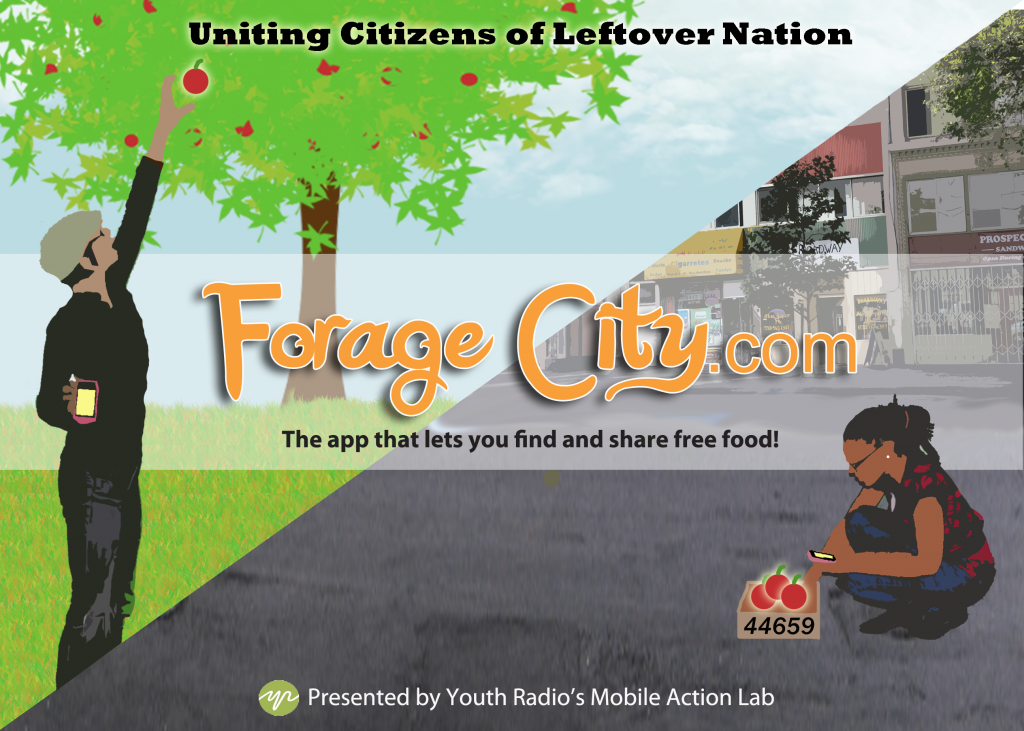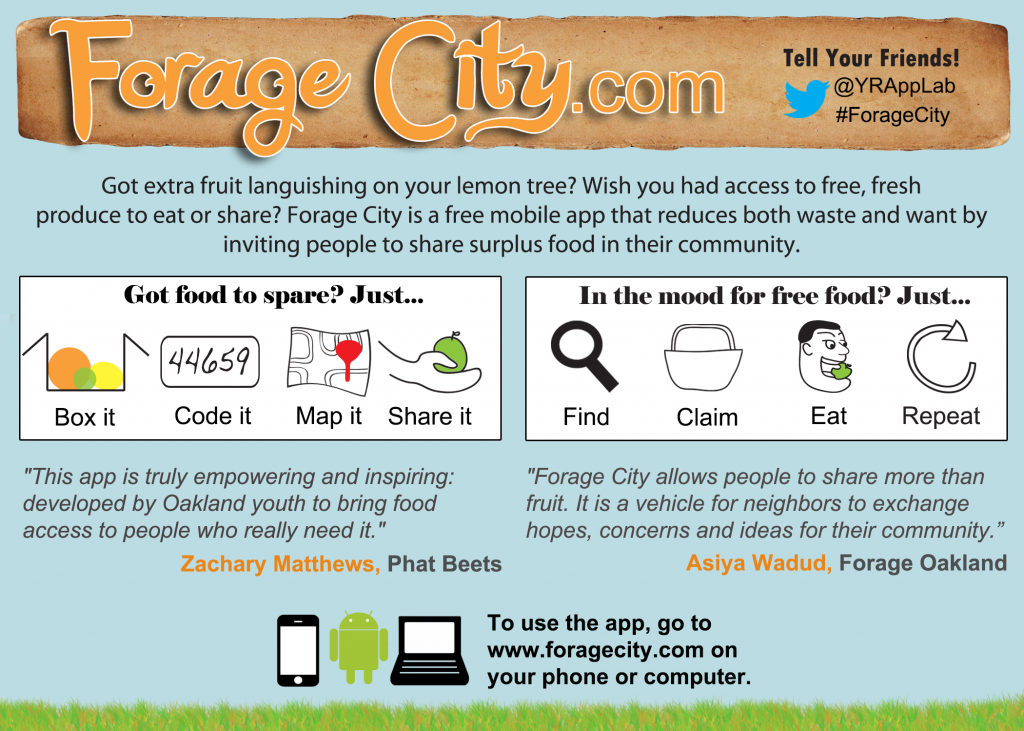
Personal Reflections
As you can tell from this site, lots of young people and partners have worked together to create Forage City. Two of the young people who joined the process when we were finishing up the first design phase are Christina So and Donta Jackson. Below are their reflections on what they learned from their time as leaders on the Forage City creative team.
Christina So, 17 years old
“Contrary to my original belief that an app is done once it has been created, an application is actually more like a child or pet you have to raise…Bugs kept popping up all over the place and once one bug was fixed, another bug arose. With each change to the app, Forage City seemed to get better.” Christina’s Full Reflection Below
Donta Jackson, 18 years old
“Creating apps has changed my perspective on computers and these so called ‘smartphones.’ See, I realize that phones aren’t smart until you tell them what to do. They are called smartphones, because the programmer created “smart” software for them. Without those capabilities, the device is just plastic, metal, and glass. Through the App Lab, we’re learning to become programmers…” Donta’s Full Reflection Below
Thoughts on Forage City, by Christina So
When I first heard about the app lab, I thought, ‘Oh, a place to create apps, which means that it’s also a place where I can play with apps!’ Well, as it turns out, the first part was true, but the second part was not entirely correct. App Lab isn’t just a place to play with cool new apps that have recently appeared on iTunes. Nor do apps just refer to applications on iOS devices, as I eventually learned. The Mobile Action Lab is a place where young people can learn how to create and use technology to help their community. And Forage City, a web-based app created by Youth Radio’s Mobile Action Lab, is the perfect example of that.
When I first started interning in the Mobile Action Lab, Forage City was already close to completion. The basic functions of the app were already incorporated into the beta version, which had yet to be launched. The layout and design were already completed. All that was left was to advertise the app and plan the launch.
Now, as simple as that seems to be, it was actually pretty difficult. Having little interest in designing, I had never intentionally used Adobe Photoshop to make a design of any kind. But wouldn’t you know it, one of my co-workers, Donta, and I were given the task to make a postcard to advertise the app and its launch day. Needless to say, I was somewhat stumped. I had no idea where to start or what the postcard should include. Truth be told, at that time, I had not even figured out what the purpose of the app was. Thankfully, Donta, the most creative and helpful person in the world, took ahold of a neon green glow stick and pointed the way down the correct path to creating the best Forage City postcard ever.


From then on, designing on Photoshop was much, much easier, especially after Teresa, a professional Photoshop user, gave us a few lessons. I learned more about photoshop and designing as the day of launch drew closer.
Around three days before the launch, the Mobile Action Lab taught me another skill: public speaking. I was to present Forage City’s functions, usage and purpose to a group of people at a hackathon, Code for Oakland. Naturally, I freaked out. I was not a very good public speaker. In fact, I used to get all jittery and have minor panic attacks. Now, with the help and encouragement of everyone in Youth Radio, my public speaking skills are superb compared to what they had been before.
Besides learning how to use Photoshop and the like, I also learned the technical process of creating an app, from beginning to end. During, before, and after creating an app, market research, user research and user testing was needed. I also learned the term “iteration,” which was highly essential in the process of creating an app. Contrary to my original belief that an app is done once it has been created, an application is actually more like a child/pet that you have to keep coming back to and changing. Nor was making an app an easy feat. There were so many problems that occurred at once and over a period of time. Bugs kept popping up all over the place and once one bug was fixed, another bug arose. With each change to the app, Forage City seemed to get better. It was like taking two steps forward and one step back. The app needed constant changes, which were sometimes better and sometimes worse.
All in all, I believe that the production of Forage City really allowed me to improve in areas that I didn’t know I needed improvement in and strengthened my strong points. It has definitely added valuable information and experience that I will never forget.
Thoughts on Forage City, by Donta Jackson
“I really believe that this app will end hunger in the world. . . or at least in the States.” This was my initial and current thought about Forage City. Forage City has come a long way. The idea started with our partner Asiya Wadud’s project, Forage Oakland. Asiya went door to door collecting fruit from her neighbors’ backyards. Then she redistributed the produce in that same community, so people could have a vast array of fruit without paying money or taking a trip to the local supermarket.
After running Forage Oakland for a while, Asiya wanted to go to grad school and didn’t have time to continue these random acts of kindness, so she reached out to us at the Mobile Action Lab to create a tech/self-help version of this physical process.
We went through various steps, from rapid ideation to research and marketing. The process was straining on my boss, who wanted to show off our work every time something good was accomplished, which was every other day. After countless days, hours of frustration, and continuous worries of not finishing on time, we finally created the first version of Forage City. We knew it would be inevitable that people would want to hear about it. Our buzz was created after a presentation we gave at Code for Oakland, when we did a soft launch of Forage City Beta. I was able to get over my fear of public speaking and keeping someone’s attention. Our staff was on point and greeted everyone in the building, and we had the biggest audience of all the workshops at the Hackathon.
Creating apps has changed my perspective on computers and these so called “smart phones.” See, I realize that phones aren’t smart until you tell them what to do. They are called smart phones, because a programmer created “smart” software that allows you to do everything from applying effects to a picture, to using the screenshot functionality, and everything in between. Without those capabilities, the device is just plastic, metal, and glass. Through the Mobile Action, we’re learning to become programmers, so we can make phones smart, too.
Youth Radio is a youth driven organization with close ties to various media outlets and networks, so we’re in an excellent position to be making apps. Also, Youth Radio’s name is popular in Oakland, so talking to the locals was a piece of cake.
Forage City has gotten lots of publicity in print, online, and on the TV news. We also visited local farmers’ markets and passed out our postcards while using word-of-mouth to get people and programs with excess food to use the app. We came to a bump in the road when we realized the people who tested the app for us weren’t using its full functions, so we decided to share everything we’ve learned and produced along the way, including the code, so you can make a Forage City for your very own community.